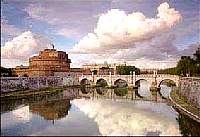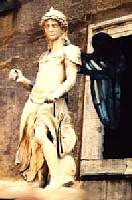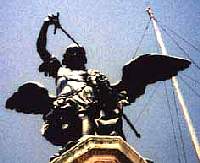Rome
 |
| Castel Sant'Angelo, Rome |
No tourist or pilgrim in the Eternal City can avoid seeing the shining gilded angel on the top of Castel Angelo. This angel is there in memory of a revelation of St. Michael. In 589 the river Tevere overflowed its banks and as a consequence a plague broke out. Gregorius the Great was elected pope in 590. He organised and led a penitential procession through Rome, and all the inhabitants prayed for the liberation from this deadly illness. It is said that about 80 people died only during the procession. The Pope carried a picture of the blessed virgin. Some say it was painted by St. luke. It is still kept in Santa Maria Maggiore.
 |
| The statue of Saint Michael by Raffaello da Montelupo,1544, Castel Sant'Angelo in Rome |
The procession reached Ponte Alieno. This bridge connects Emperor Hadrian's enormous mausoleum with the city. From then on it is known as Sant'Angelo. When the penitential procession approached this point a dense cloud of bad smelling air was seen to hover in front of the painting. On the top of the big monument Gregorius saw an angel sheathing a blood-stained sword while other angels were singing Regina Coeli laetare. The Pope uttered:: Pray for us to the lord, hallelujah! This became the Angelus of Easter. At this point the plague stopped unexpectedly.
 |
| The bronze-statue of Saint Michael by Vershaffelt and moulded by Giardoni,1752, at the top of Castel Sant'Angelo |
Some years later Pope Bonifacius IV (608-15) built a chapel in honour of St. Michael on the top of the big mausoleum. The chapel on the roof was later substitut ed for a statue which during the centuries has often been destroyed and equally often put back in its place. This is how the emperor´s mausoleum got the name of Castel Sant'Angelo.
In France there is another famous sanctuary consacrated to St. Michael, not far from the coast of Normandy, on the English Channel. In 708 Michael appeared before St. Hubertus, bishop of Avranches, asking him to build a sanctuary. Michael himself chose the place. The festival when the original sanctuary was consecrated to Michael was celebrated 16 Oct. 709. The Normans built successively a big sanctuary on the small rocky island rising unexpectedly not far from the coast. The rock in the form of a cone rises 234 feet out of the sea., which corresponds to a building of at least 20 floors. On its highest peak the sanctuary is situated and on its top there is a giant statue of St. Michael swinging a blazing sword. The archangel presses Satan down under his iron shoe. This sanctuary was begun in 1023.